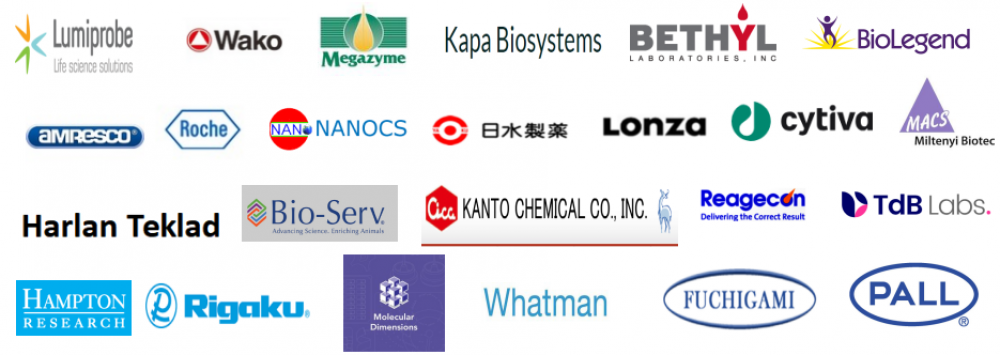Oxoid CM0920B 酵母霉菌琼脂YEAST AND MOULD AGAR
OXOID CM0920B酵母霉菌琼脂
英文名称:YEAST AND MOULD AGAR
产地/品牌:英国OXOID
规 格:500g
货 号:CM0920B
Dehydrated Culture Media
YEAST AND MOULD AGAR
Code: CM0920
A medium for the isolation of yeasts and moulds.
用于分离酵母菌和霉菌的培养基。
| Typical Formula* |
gm/litre |
| Yeast extract |
3.0 |
| Malt extract |
3.0 |
| Peptone |
5.0 |
| Dextrose |
10.0 |
| Agar |
20.0 |
| Final pH 6.2 ± 0.2 @ 25°C |
* Adjusted as required to meet performance standards
Directions
Suspend 41.0g in 1 litre of distilled water and bring to the boil to dissolve. Sterilise by autoclaving at 121°C for 15 minutes. The medium may be rendered selective after sterilisation by acidifying to pH 4.0 with 12-15ml of Lactic Acid SR0021 after cooling to 50°C. Do not reheat after making this addition. Mix well and pour into sterile Petri dishes.
Description
Yeast and Mould Agar is based on the formulation described by Wickerham1,2. The medium is recommended for the isolation and maintenance of yeasts and moulds.
Yeast and Mould Agar may be rendered selective by the addition of acid to reduce the pH of the medium to pH 4.0. A suitable acid for use is Lactic Acid SR0021.
Yeast and Mould Agar has now been formulated specifically for suitability within the Brewing Industry, for detection of both saccharomyces and non saccharomyces wild yeasts in the presence of culture yeast.
The use of MYGP + Copper Medium was described by Taylor and Marsh for selective isolation of wild yeasts in the presence of culture ale or larger yeasts3.
The medium utilises the the different sensitivities of wild yeast vs.culture ale or lager yeast to the inhibitory action of copper. This enables wild yeasts to grow on the medium whilst suppressing growth of culture yeast.
The authors recognised that variation in raw materials, including peptones, malt and yeast extract and agar, in the formulation could markedly affect the performance of the medium by neutralising the inhibtory action of the copper, resulting in overgrowth of the wild yeasts by culture yeast.
Careful selection of the raw materials by Oxoid has eliminated this variability, and the medium has been optimised for addition of copper, usually within the range 50-300 mg/litre depending on the sensitivity of the culture yeast to copper, as recommended by the Institute of Brewing Methods of analysis4.
The complete medium is recommended for examination of the microbiological quality of beers in process, pitching yeasts and packaged beers.
Technique
1. Prepare Yeast and Mould Agar plates as directed in the directions for use.
2. Inoculate the medium by surface or poured plate procedures.
3. Incubate the plates for 5 days at 25-30°C.
Detection and enumeration of yeasts in the presence of moulds may be made easier by using a combined anaerobic/aerobic incubation procedure5.
Cultures are initially incubated for 3 days under anaerobic conditions and then for a further 2 days aerobically. Development of mould colonies is impeded during the anaerobic phase of incubation. Dimorphic moulds e.g. mucor spp may form yeast- like colonies during anaerobic incubation.
Technique
Cultures on plates or membrane filters are incubated for 3 days at 25°C under strictly anaerobic conditions. Continue incubation of the cultures under aerobic conditions for a further 2 days. Yeast colonies may be very small immediately following anaerobic incubation but will increase in size in air. Mould growth may become completely unrestricted after 3 days in air.
Storage conditions and Shelf life
Store the dehydrated medium at 10-30°C and use before the expiry date on the label.
The prepared medium may be stored for up to 2 weeks at 2-8°C.
Appearance
Dehydrated medium: Straw coloured, free-flowing powder
Prepared medium: Straw coloured gel
方向
将 41.0g 悬浮在 1 升蒸馏水中并煮沸溶解。通过在 121°C 高压灭菌 15 分钟进行灭菌。在冷却至 50°C 后,通过用 12-15ml 乳酸 SR0021 酸化至 pH 4.0,可以使培养基在灭菌后具有选择性。添加后不要重新加热。充分混合并倒入无菌培养皿中。
描述
酵母菌和霉菌琼脂基于 Wickerham1,2 描述的配方。该培养基推荐用于酵母和霉菌的分离和维护。
酵母和霉菌琼脂可以通过添加酸将培养基的 pH 值降低到 4.0 来提高选择性。适合使用的酸是乳酸 SR0021。
酵母菌和霉菌琼脂现已专为酿造行业的适用性而配制,用于在存在培养酵母的情况下检测酵母菌和非酵母菌的野生酵母。
Taylor 和 Marsh 描述了使用 MYGP + 铜培养基在存在培养啤酒或更大酵母菌的情况下选择性分离野生酵母菌 3。
该培养基利用野生酵母与培养麦芽酒或贮藏啤酒酵母对铜抑制作用的不同敏感性。这使得野生酵母能够在培养基上生长,同时抑制培养酵母的生长。
作者认识到,配方中原材料(包括蛋白胨、麦芽和酵母提取物和琼脂)的变化可能会通过中和铜的抑制作用而显着影响培养基的性能,从而导致培养酵母过度生长野生酵母。
Oxoid 对原材料的仔细选择消除了这种可变性,并且培养基已针对添加铜进行了优化,通常在 50-300 毫克/升的范围内,具体取决于培养酵母对铜的敏感性,正如研究所所推荐的那样酿造方法分析4。
建议使用完全培养基来检查加工中的啤酒、发酵酵母和包装啤酒的微生物质量。
技术
1. 按照使用说明准备酵母和霉菌琼脂板。
2. 通过表面或倾板程序接种培养基。
3. 将板在 25-30°C 下孵育 5 天。
通过使用结合的厌氧/好氧培养程序,可以更容易地检测和计数存在霉菌的酵母菌5。
培养物最初在厌氧条件下培养 3 天,然后在需氧条件下再培养 2 天。霉菌菌落的发育在孵化的厌氧阶段受到阻碍。二态模具,例如mucor spp 可能在厌氧培养过程中形成酵母样菌落。
技术
平板或膜过滤器上的培养物在 25°C 严格厌氧条件下培养 3 天。在有氧条件下继续培养培养物 2 天。厌氧培养后酵母菌落可能非常小,但在空气中会增大。在空气中 3 天后,霉菌的生长可能会完全不受限制。
储存条件和保质期
将脱水培养基储存在 10-30°C 并在标签上的有效期之前使用。
制备的培养基可在 2-8°C 下储存长达 2 周。
外貌
脱水介质:稻草色、自由流动的粉末
制备培养基:稻草色凝胶
Quality control
| Positive controls: |
Expected results |
|
|
pH 6.2 |
pH 4.0 |
|
| Aspergillus brasiliensis ATCC® 16404 * |
Good growth; white mycelium, black spores |
Good growth; white mycelium, black spores |
| Candida albicans ATCC® 10231 * |
Good growth; cream coloured colonies |
Good growth; cream coloured colonies |
| Eschericia coli ATCC® 25922 * |
Good growth; straw coloured colonies |
Partial to complete inhibition |
* This organism is available as a Culti-Loop®
Precautions
For in vitro diagnostic use.
Do not use beyond the stated expiry date or if the product is caked, discoloured or shows any sign of deterioration.
References 参考文献
1. Wickerham L.J. (1951) U.S. Dept. Agric. Tech. Bull. No 1029, 1-19.
2. Wickerham L.J. and Rettger L.F (1939) J. Tropical Med. Hyg. 42. 174-179.
3. Taylor, G.T. and Marsh, A.S. (1984) J. Inst. Brew., 90: 134-145.
4. Institute of Brewing Methods of Analysis. 1997 Vol. 2 Microbiological. 23.45
5. De Jong J. and Put H.M.C. (1980) Biology and Activities of Yeasts. Society for Applied Bacteriology Symposium series No. 9. Skinner F.A., Passmore S.M. and Davenport R.R. (eds). Academic Press, London. Pages 289-292.
